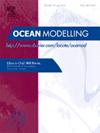Deep learning-based solution for the KdV-family governing equations of ocean internal waves
IF 3.1
3区 地球科学
Q2 METEOROLOGY & ATMOSPHERIC SCIENCES
引用次数: 0
Abstract
Internal Solitary Waves (ISWs) are critical for ocean studies due to their large amplitude and long-travel capabilities. Conventionally, the Korteweg-de Vries (KdV) equations and their extensions are employed to simulate ISW properties, but traditional numerical methods lack flexibility and efficiency. This study introduces a universal, deep learning-based model that streamlines solving KdV-family equations. Within the framework of physics-informed neural networks, we implement an optimized Radial Basis Function (RBF) neural network and a new progressive expansion training strategy. This innovation minimizes error during training, leading to efficient convergence. Our model is tested on KdV and forced KdV equations, dimensional and non-dimensional equations using soliton, cnoidal, and dnoidal waveforms to simulate ISW propagation. The model results align with theoretical and numerical benchmarks, as demonstrated in a case study in the Sulu Sea. This paper does not concern ISW dynamics but uses the KdV equation as an example to showcase how to solve the partial differential equations with a new deep-learning method. The developed deep-learning model offers an efficient and accurate approach to solving KdV-family equations in oceanographic studies.
基于深度学习的海洋内波kdv族控制方程解
内孤立波(ISWs)由于其大振幅和长传播能力而对海洋研究至关重要。通常采用Korteweg-de Vries (KdV)方程及其扩展来模拟ISW的性质,但传统的数值方法缺乏灵活性和效率。本研究引入了一个通用的、基于深度学习的模型,简化了求解kdv族方程的过程。在物理信息神经网络框架内,我们实现了一种优化的径向基函数(RBF)神经网络和一种新的渐进式扩展训练策略。这种创新减少了训练过程中的错误,从而实现了有效的收敛。我们的模型在KdV和强制KdV方程、量纲和无量纲方程上进行了测试,使用孤子、余弦和齿状波形来模拟ISW的传播。模型结果与理论和数值基准一致,并在苏禄海进行了案例研究。本文不涉及ISW动力学,而是以KdV方程为例,展示了如何用一种新的深度学习方法求解偏微分方程。所开发的深度学习模型为解决海洋学研究中的kdv族方程提供了一种高效、准确的方法。
本文章由计算机程序翻译,如有差异,请以英文原文为准。
求助全文
约1分钟内获得全文
求助全文
来源期刊

Ocean Modelling
地学-海洋学
CiteScore
5.50
自引率
9.40%
发文量
86
审稿时长
19.6 weeks
期刊介绍:
The main objective of Ocean Modelling is to provide rapid communication between those interested in ocean modelling, whether through direct observation, or through analytical, numerical or laboratory models, and including interactions between physical and biogeochemical or biological phenomena. Because of the intimate links between ocean and atmosphere, involvement of scientists interested in influences of either medium on the other is welcome. The journal has a wide scope and includes ocean-atmosphere interaction in various forms as well as pure ocean results. In addition to primary peer-reviewed papers, the journal provides review papers, preliminary communications, and discussions.
 求助内容:
求助内容: 应助结果提醒方式:
应助结果提醒方式:


